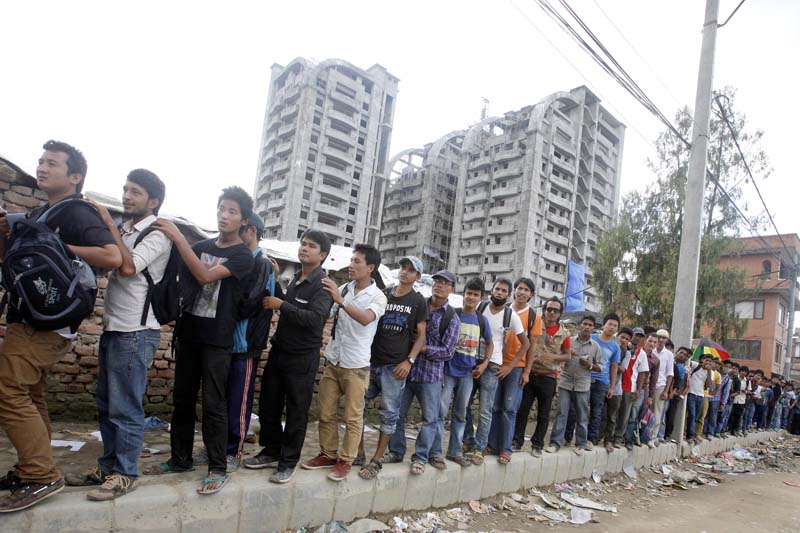Educated and qualified, but no job for us
The unemployment situation in the country is a serious concern, says Sunita Lohani looking at this grave situation which has worsened post quake
Finding one’s dream job as per one’s qualification and securing a comfortable life for one’s family and oneself — it is ‘the’ dream of almost every individual. But not all Nepali youth get their dream job, or a well-paid job in their homeland. Every year at least 300,000 to 400,000 youth arrive in the Nepali job market in search of a job, but only five per cent of them are able to land a job in the country, according to the Nepal Labour Survey 2015.
The remaining are either forced to leave the country in search of employment opportunities somewhere far off, or accept under-paid jobs that are not worthy of their qualifications.
Overflow of applications
When the Employment Permit System (EPS), Korea branch in Kathmandu, announced vacancy for 3,100 workers to work in South Korea recently, some 60,600 people dropped their applications. This is just an example of people’s attraction towards foreign employment.
No less was the number of applicants when the Public Service Commission (PSC) announced vacancies in 5,000 different posts in January. A total of 5,060,000 applications were dropped for 5,000 posts, according to PSC.
Whether educated or uneducated, the number of unemployed is large in the country — and this not only makes it difficult for youngsters to earn a living, the country’s economy is also affected.
According to the Central Bureau of Statistics 2014, a total of 4,000,200 people are not getting jobs befitting their qualification and skills. It further reveals that the illiterate unemployment (unemployed and illiterate) is 2.1 per cent in the country, whereas literate/educated unemployment (unemployed despite having a college degree) rate is 4.1 per cent.
The survey also states that 40,000 to 50,000 people, who have Bachelor’s or Master’s degrees, are unemployed in the country.
And addressing the youth who leave for the Gulf countries and other nations in search of employment opportunities, he says, “Those going to the Gulf countries are the ones who can invest more than Rs 100,000. Our fund (YSEF) is for those who are penniless.”
The Gorkha Earthquake, unofficial blockade and forest fires are also paralysing the country’s economy. Statistics from the General Federation of Nepalese Trade Unions (GEFONT) claims that 800,000 jobless people have been added in the market post-quake — due to collapse of industries’ infrastructure and political turmoil in the country.
More than 800 Nepali youth leave the country every day — in pursuit of a better life and happiness, as per the Labour Department.
In such a condition, President Bidhya Bhandari presented the government’s policy and proposed programmes for the upcoming fiscal year 2016/17 at the Legislature-Parliament on May 8. Among others, it addresses the problem of job scarcity and has provision for youth self-employment programmes. If approved, it is hoped that it should be able to address the country’s problem of unemployment to some extent.
How to get a loan from YSEF?
Any unemployed Nepali citizen, who is 18 years of age and is below 50, is eligible to apply for the loan from YSEF. Anyone fulfilling the criteria could get a loan of up to Rs 200,000 via bank and cooperatives that have partnered with YSEF. You need to be the shareholder member of the bank or the cooperative to get the loan.
Similarly, groups can also apply for the loan — maximum 25 people can be in a group, and each individual in the group can get a loan up to Rs 200,000.
These cooperatives and bank charge interest up to 12 per cent. A total of 624 cooperatives are providing loans in the entire country via YSEF programme.
YSEF is more focused towards the people from marginalised communities, disadvantaged groups and those from rural areas. One gets loan for agriculture, animal farming, small scale entrepreneurship, traditional profession, home stay business, business of local raw material, et cetera.






